Leigh Donlan reported from San Jose’s Center for the Performing Arts:
After a three week tour of Spain, the Silicon Valley Ballet came home to San Jose for a weekend of performances, a program which included a company première and which closed with Ohad Naharin’s powerful Minus 16.
Finnish choreographer Jorma Elo’s Glow-Stop adorned the dancers with red velvet costumes and golden lighting (by Zach Brown and Brad Fields, respectively) as they moved with an incessant urgency to Mozart’s Symphony No.28, the women leaping precariously into their partner’s lifts, followed by reluctant low drags. Once the score transitioned to Philip Glass’ Tirol Concerto, their bodies appeared grateful for the slower, more manageable choreography. Yet absent live music, their connection to the score was mechanical and uninspired. Thankfully, soloist Akira Takahashi’s robust musical instincts brought some life to the sections that he was in.
Where recorded music did work was in Prism, choreographed by Colombian-Belgian-born Annabelle Lopez Ochoa. This 30-minute work did justice to Keith Jarrett’s astonishing Köln Concert, recorded live in Germany in 1975. Mirroring the hypnotic and seductive solo-piano improvisation, the dancers eased in and out of multi-layered moods. Jarrett’s grunts, moans and exhalations were perfectly synced with a contraction, an extension or a release from the moving bodies, and the original Clifton Taylor lighting – re-imagined by David K. H. Elliott – bespoke a prism of colors refracted through water. Ommi Pipit-Suksun was mesmerizing in a pas de deux with Rudy Candia, her lithe body owning each jarred musical note with a sumptuous hunger – a true pleasure to watch.
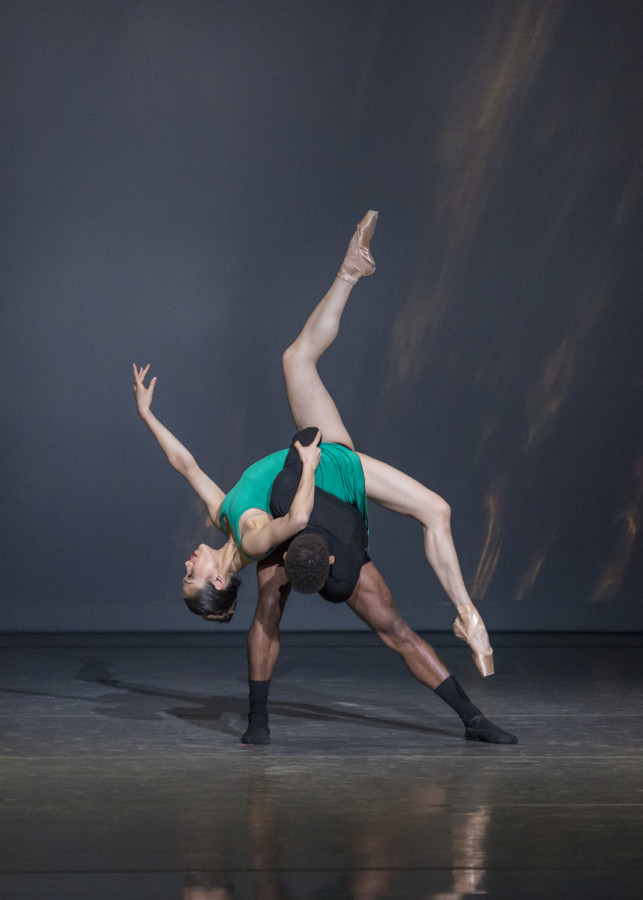
Lahna Vanderbush and Ihosvany Rodriguez in Annabelle Lopez Ochoa’s Prism (Company premiere)
(Photo: Alejandro Gomez)
But the showstopper was Minus 16 by Ohad Naharin, the Israeli artistic director of the Batsheva Dance Company. Using a combination of improvisation and Naharin’s “Gaga” technique (which emphasizes the exploration of each person’s individuality through movement) the work requires such an extreme range of movement from dancers that it ought to be required repertoire for any major dance company.
Francisco Preciado was irresistible as he took the stage during intermission with jazz improv set to a crooning Dean Martin. As dancers settled into a semicircle of chairs, we hear the words, “The illusion of beauty and the fine line that separates madness from sanity, the panic behind the laughter and the coexistence of fatigue and elegance.” Then the traditional Hebrew song of “Echad Mi Yodea” (Who knows One?) commences, followed by 13 rounds of Gaga chair dancing and a shouted chorus of “She ba-shamaim u va-aretz” (“Who is in the heaven and the earth?”) while the dancers gradually disrobe from suits to their undies.
Full of surprises, the piece comprised unconnected scenes drawn from different Naharin works. A later scene called for some audience participation, as dancers brought members onstage for a variety of complex dances, including the mambo – a highlight that sent many patrons home smiling. During their multiple standing ovation curtain calls, most of the dancers continued to go Gaga, lapping up this newfound freedom of expression.
Carreno’s dynamic choices of international repertoire are producing remarkably well-rounded performers. The only questionable program element was the uneventful opener, Diana and Actaeon. This brief Petipa classic pas de deux was an unnecessary sleeper that could not be rescued by a solid presentation from principals Junna Ige and Maykel Solas; the unflattering costumes and lighting simply made matters worse. Fortunately, Ige’s unflinching technical precision and Solas’ masterful partnering were evidence enough of why this is a world class ballet company.
– Director’s Choice runs through Sunday, Feb 21. See the company website for details. –




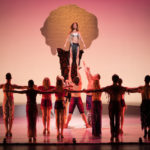
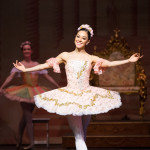
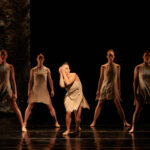
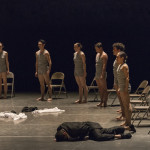
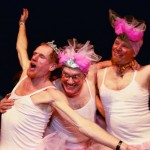
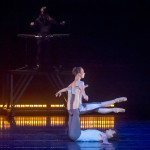
Hm. Leigh and I sat next to each other on opening night and it appears we did not see eye-to-eye: http://ww2.kqed.org/arts/2016/02/20/anna-lopez-ochoas-prism-gleams-at-silicon-valley-ballet/
Not quite on this one. To be fair, I loved Prism (especially the music) but felt there were too many “pretty picture” moments. It was Minus 16 that demanded more from the dancers- passion, intensity and wild abandon- all very good lessons in performance.
Very true about the many “pretty picture” moments but I thought they were meant to reflect those transitions in the music where Keith Jarrett was noodling around – those transitions in which he was trying to latch on to a new melody or a new rhythm. As if the dancers were saying to the composer “OK we’ll hang out in this pose while you figure out where you’re going next.”
And also I thought there was a satirical feel to the piece, making fun of some ballet stereotypes like the heroic lifts in Soviet ballet and the scary psychological ballets.
I am ambivalent about Minus 16. On the one hand I find it very moving and, as you wisely point out, it stretches ballet dancers in a way that is probably very good for them. On the other hand, I feel like it belongs to Naharin’s company. So other companies are sort of impostors for thinking they can find the soul of this piece. I don’t feel that way about Balanchine or Kylian or other choreographers though. Not sure why I don’t.
Then all choreography would be impostering, unless it’s danced only by the person who creates it.
The soul of this piece is in whoever performs it, if they let it come through. It may take some time to weed through all the muck in their heads to get to that authentic movement, but it’s in there.
Balanchine and Kylian work from the same vocabulary- this leg, this direction, here by 8- external commands within a limited set of variables . Naharin’s language allows dancers to connect the endless possibilities of a movement (and movements within movements) within themselves without anyone dictating what that movement should be for them. So yes, people would feel like imposters if they tried approaching this theory like they do ballet or other dance forms that are dependent upon a certain structure. But they’d be missing the point. The point is to release physical (really mental) limitations.
He also doesn’t use mirrors in his classes, which I think is wonderful. An old Vaganova teacher of mine periodically did this, as do many other teachers. Point is, it helped me go deeper into my movements because I FELT what I was doing more.
Ah I think you’ve just changed my mind about Minus 16 with that very insightful point about Gaga.